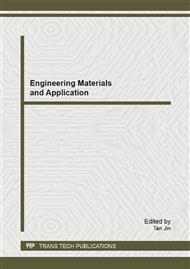p.109
p.115
p.120
p.126
p.131
p.137
p.143
p.148
p.154
An Investigation of Injection Times Affect on Properties of Recycled Glass Fiber Reinforced Flame Retardant PBT
Abstract:
Due to its excellent comprehensive properties, glass fiber reinforced flame retardant PBT was widely applied in electrical accessory. In this paper, the recycled glass fiber reinforced flame retardant PBT(RGFFRPBT)with injection times effect on its carboxyl content, characteristic viscosity of PBT and the average length of glass fiber were studied. The properties of RGFFRPBT PBT including mechanical, thermal and rheological properties were well investigated. The results demonstrated that when GFFRPBT was injected third time, the length of glass fiber and characteristic viscosity of PBT decreased from 895um, 0.95 to 590um, 0.52, respectively. It also indicated that the decrease trend would accelerate with higher injection times. When the injection times were twice, the notched impact strength, flexural and tensile strength of RGFFRPBT-2nd decreased to 54J/m, 128MPa and 96.1MPa, respectively. Thermal stability, maximal crystallization temperature, melting point and HDT of RGFFRPBT-2nd were not significant differed to those of GFFRPBT. When the injection times were higher than three times, all of the properties decreased drastically. With the increasing of injection times, the samples show shear-thinning and nonlinear viscoelastic properties and the shear viscosity decreased, distinctly. The results illuminated that mechanical and thermal properties of RGFFRPBT-2nd were suitable to use in the electronic and electric field.
Info:
Periodical:
Pages:
131-136
Citation:
Online since:
January 2013
Authors:
Keywords:
Price:
Сopyright:
© 2013 Trans Tech Publications Ltd. All Rights Reserved
Share:
Citation:


